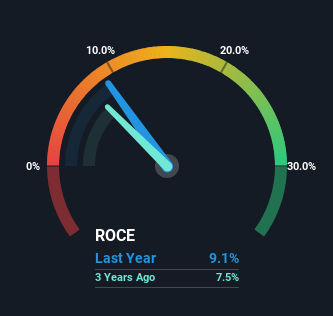Returns On Capital At Taylor Wimpey (LON:TW.) Paint A Concerning Picture
If we want to find a stock that could multiply over the long term, what are the underlying trends we should look for? Firstly, we'll want to see a proven return on capital employed (ROCE) that is increasing, and secondly, an expanding base of capital employed. This shows us that it's a compounding machine, able to continually reinvest its earnings back into the business and generate higher returns. However, after investigating Taylor Wimpey (LON:TW.), we don't think it's current trends fit the mold of a multi-bagger.
What Is Return On Capital Employed (ROCE)?
Just to clarify if you're unsure, ROCE is a metric for evaluating how much pre-tax income (in percentage terms) a company earns on the capital invested in its business. Analysts use this formula to calculate it for Taylor Wimpey:
Return on Capital Employed = Earnings Before Interest and Tax (EBIT) ÷ (Total Assets - Current Liabilities)
0.091 = UK£467m ÷ (UK£6.3b - UK£1.1b) (Based on the trailing twelve months to December 2023).
So, Taylor Wimpey has an ROCE of 9.1%. On its own that's a low return on capital but it's in line with the industry's average returns of 9.3%.
View our latest analysis for Taylor Wimpey
In the above chart we have measured Taylor Wimpey's prior ROCE against its prior performance, but the future is arguably more important. If you'd like to see what analysts are forecasting going forward, you should check out our free analyst report for Taylor Wimpey .
How Are Returns Trending?
When we looked at the ROCE trend at Taylor Wimpey, we didn't gain much confidence. Over the last five years, returns on capital have decreased to 9.1% from 22% five years ago. Given the business is employing more capital while revenue has slipped, this is a bit concerning. This could mean that the business is losing its competitive advantage or market share, because while more money is being put into ventures, it's actually producing a lower return - "less bang for their buck" per se.
The Key Takeaway
From the above analysis, we find it rather worrisome that returns on capital and sales for Taylor Wimpey have fallen, meanwhile the business is employing more capital than it was five years ago. And, the stock has remained flat over the last five years, so investors don't seem too impressed either. Unless there is a shift to a more positive trajectory in these metrics, we would look elsewhere.
If you'd like to know more about Taylor Wimpey, we've spotted 2 warning signs, and 1 of them shouldn't be ignored.
For those who like to invest in solid companies, check out this free list of companies with solid balance sheets and high returns on equity.
Have feedback on this article? Concerned about the content? Get in touch with us directly. Alternatively, email editorial-team (at) simplywallst.com.
This article by Simply Wall St is general in nature. We provide commentary based on historical data and analyst forecasts only using an unbiased methodology and our articles are not intended to be financial advice. It does not constitute a recommendation to buy or sell any stock, and does not take account of your objectives, or your financial situation. We aim to bring you long-term focused analysis driven by fundamental data. Note that our analysis may not factor in the latest price-sensitive company announcements or qualitative material. Simply Wall St has no position in any stocks mentioned.

